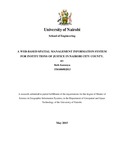| dc.description.abstract | The manner in which geographic data is acquired, processed and applied continues to change with advancing technology. This study focused on the development of a web-based spatial management information system for the justice institutions in the Nairobi City County. The overall objective of the study was to develop a web-based spatial management information system for the institutions of justice in Nairobi City County.
The study area was Nairobi City County, and the institutions of interest were the police, prisons, courts, civil societies and the human rights commissions. The data was acquired from direct field visits to these institutions of justice, through which comprehensive attribute data for all these features was developed. Administrative boundaries data was also used, most of it coming from the Independent Electoral and Boundaries Commission (IEBC). Nairobi Population data was also used which was sourced out from the Kenya 2009 Census data. Smart mobile phone handsets were used to collect data from these institutions. Data collected was edited, verified before uploading it on the on the Justice, Law and Order (JLO) database. HyperText Markup Language (HTML) was used to create a front-end user interface. Google Maps JavaScript Application Programming Interface (API) was used to embed maps on the web pages. ArcGIS online was used as the web-GIS application with a six months online subscription.
The final output was a web-based spatial management information system that displays layers of the institutions of justice in Nairobi City County, with added functionality such as pan, zoom and query. Analysis of the population of these institutions verses the population of the Nairobi City County residents was conducted, analysis of the various resources at the disposal of these institutions was also carried out.
The finding of this study was that GIS is a viable proposition for use with institutions of justice, and a web-based spatial MIS adds value in the management of information. The web-based MIS provided a suitable option for performing analysis, presenting information and sharing information with the interested stakeholders within the justice system.
With the current trend in Information and Communication Technology (ICT) there is more adoption of the web technology due to ubiquitous access and also due to the low cost of ownership of internet-based solutions. | en_US |

